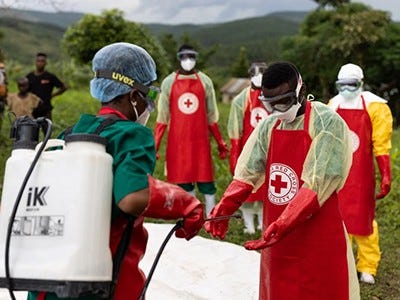continuous health transformation
multidisciplinary institute
Joaquim Cardoso MSc
Founder and Chief Researcher & Officer
December 24, 2022
This is a republication of the article “Even after COVID, the world’s vaccine strategy is failing”, published on “Nature”, with the title above.
Nature
Seth Berkley
December 13, 2022
Without a global, publicly funded strategy, the market will fail to deliver vaccines to stop pandemics before they surge.
Four weeks ago, I visited Mulago National Referral Hospital, in Kampala, where I used to work. Today, it is home to one of Uganda’s Ebola isolation wings.
During my visit, I witnessed some of the challenges that the government and health-care workers were facing to contain this terrible outbreak without the most effective tool there is: vaccines.
The Sudan strain of ebolavirus has killed 56 people and spread to 9 districts in Uganda, including the capital city of 2 million people and regions that border other nations. If it spills into neighbouring countries, it could trigger a regional crisis.
The Sudan strain of ebolavirus has killed 56 people and spread to 9 districts in Uganda, including the capital city of 2 million people and regions that border other nations. If it spills into neighbouring countries, it could trigger a regional crisis.
All of this could have been avoided. No effective vaccines or treatments have been approved against Sudan ebolavirus.
If the world had learnt its lesson from previous Ebola outbreaks and COVID-19, vaccines could have been ready for clinical testing at the outbreak’s start. The fact that they aren’t is a global failure.

Despite rallying to produce billions of doses of vaccines in the face of COVID-19, when it comes to developing vaccines to prevent a disease in the first place, the world is still asleep at the wheel.
There is still no incentive for markets to deliver vaccines that can prevent outbreaks, even when the technology is available.
If we can’t even have vaccines ready for known severe threats such as Ebola, then what hope is there for future unknown pandemic threats?
I warned about this problem seven years ago in a column in Nature ( S. Berkley Nature 519, 263; 2015). Yet despite the COVID-19 wake-up call, this remains one of the biggest chinks in our pandemic-preparedness armour.
With effective, available vaccines against devastating diseases, governments could prevent escalation through contact tracing and ring vaccination: in the case of Ebola, perhaps a few dozen contacts of each infected person could be vaccinated.
But producing the small number of doses needed to prevent spread is not profitable for drug companies, and donor governments are reluctant to waste money on preventive vaccines that might never get used.
But producing the small number of doses needed to prevent spread is not profitable for drug companies, and donor governments are reluctant to waste money on preventive vaccines that might never get used.
‘Short-sighted’ hardly describes the situation.
Preparing preventive vaccines for a few million dollars per batch should be seen as a small insurance policy to avoid a repeat of the US$12 trillion the world just spent on COVID-19.
Preparing preventive vaccines for a few million dollars per batch should be seen as a small insurance policy to avoid a repeat of the US$12 trillion the world just spent on COVID-19.

The market’s failure to support vaccines should worry everyone, because the risk of future pandemics is growing.
Even as COVID-19 continues to spread, in a given year there is a 2% chance of a new pandemic outbreak.
Climate change, population growth, urbanization and human migration all help outbreaks to spread and escalate more rapidly.
Even as COVID-19 continues to spread, in a given year there is a 2% chance of a new pandemic outbreak.
Climate change, population growth, urbanization and human migration all help outbreaks to spread and escalate more rapidly.
Our best defence is having vaccines ready to use the moment disaster strikes.
The World Health Organization keeps a list of nine priority pathogens with pandemic potential, including severe acute respiratory syndrome (SARS) and Ebola, as well as ‘disease X’, which represents a possible, as-yet-undiscovered pathogen.
All nine deserve a full effort: development of several candidate vaccines through the animal-model and early clinical testing stages; vialed and quality-tested vaccines that are ready for immediate testing in an outbreak; and stockpiling of enough doses to control the disease if the vaccine is shown to be efficacious.
For disease X, a set of viral vectors and messenger RNA delivery systems should be ready to carry the sequences of whichever antigens prove effective against the disease, and the manufacturing and clinical trials should be worked through as far as possible.
By doing much of the preclinical and clinical work in advance, we can have doses as close to ready as possible when we need them.
By doing much of the preclinical and clinical work in advance, we can have doses as close to ready as possible when we need them.

What will it take to finally catalyse change, so that I’m not writing this again seven years from now?
To be clear, we have come far, from hardly talking about this issue to living through a pandemic that daily highlights its relevance. I am optimistic that a change in mindset is in view.
A key first step is the establishment of an adequate, publicly subsidized market. This will enable a coordinated global strategy with the support of G20 governments to drive the research, development and flexible small-scale manufacturing needed to produce vaccines to prevent epidemics, even if, as we hope, they will not be needed.
Wealthy countries should take the lead. They should ensure that agencies such as the Coalition for Epidemic Preparedness Innovations (CEPI), based in Oslo, and the International AIDS Vaccine Initiative (IAVI), based in New York City, are fully funded to do this work, which will involve close collaboration with government research agencies as well as Gavi, the Vaccine Alliance, and the WHO.
For Sudan ebolavirus, three candidate vaccines have been identified in early testing, following research and development driven by CEPI, IAVI, the US National Institutes of Health, the US Biomedical Advanced Research and Development Authority and others.
Last week, Uganda received the first vaccine shipment for scheduled trials. But for the 56 people who have died and the 142 who have been infected, trials will come too late — and, as there are currently no new cases, they might be too late to determine vaccine efficacy.
COVID-19 has brought a renaissance in vaccine development. New vaccines are in the pipeline for many diseases.
We have an opportunity to capitalize on the latest methods and a sense of urgency.
We can’t continue closing the stable door after the horse has bolted. If we keep relying on a market-based model that churns out millions of doses only after an epidemic is under way, then we have already failed.
We can’t continue closing the stable door after the horse has bolted. If we keep relying on a market-based model that churns out millions of doses only after an epidemic is under way, then we have already failed.
S.B. founded IAVI and served on the research and development committee of CEPI.
Originally published at https://www.nature.com on December 13, 2022.
About the author & affiliation
Seth Berkley is chief executive of Gavi, the Vaccine Alliance.

Names mentioned
Mosoka P. Fallah is programme manager of the Saving Lives and Livelihoods Initiative at the Africa CDC in Addis Ababa, Ethiopia.













